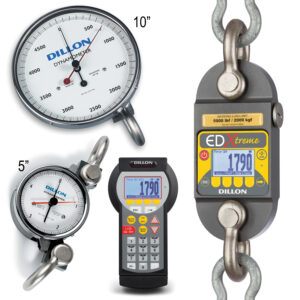5 Things to Consider When Buying a Dynamometer

Purchasing the correct force measurement equipment for your project can significantly impact the efficiency and accuracy of your operations. To ensure you make the best decision, here are 5 things to consider:
Safety Features and Load Capacity
Ensure the dynamometer can handle the maximum load required for your projects. The load capacity should cover both the highest expected load and any additional safety factors needed. Construction sites often involve a range of applications, so choosing a dynamometer capacity that slightly exceeds all loads encountered can ensure safety and longevity. With that, it is important to select a dynamometer that includes the appropriate safety factor for the application, such as a 5:1 minimum safety factor that can be applied to bridge cable tensioning or overhead lifting.
Cost Savings & Ease of Calibration
One of the main things to consider when purchasing a dynamometer is the cost. Many lower-end dynamometers advertise a lower upfront cost, but break easily, are less safe, and can be difficult to recalibrate. Dynamometers should have high-quality components to withstand the most challenging environments and last many years. A dynamometer manufactured with longevity in mind means little to no replacements, saving time and money. Choosing a dynamometer from a reputable manufacturer is recommended. Always consider the total cost of ownership, which includes frequency of repairs, ease of calibration, and lifespan of the dynamometer.
Accuracy and Resolution
The Federal Building Performance Standard and other transnational governing bodies maintain strict equipment requirements to ensure safety and performance within the construction industry. Look for dynamometers with high accuracy ratings, often expressed as a percentage of full-scale load. Higher-resolution force measurement equipment is suited for sensitive applications, such as gauging the level of force an object can withstand, building bridges, and measuring the resistance of heavy traffic in parking structures.
Durability and Environmental Resistance
Construction sites expose equipment to harsh conditions, such as dust, moisture, extreme temperatures, and rough handling. Choose a durable, weather-resistant dynamometer, and consider features like waterproofing, impact resistance, and materials like stainless steel. An ingress protection (IP) rating can give insight into how a dynamometer will hold up in more complex settings.
Display and Data Output Options
Clear, accessible data monitoring and management is important, especially when using the dynamometer in the field. Look for a dynamometer with a backlit display and, if necessary, remote or wireless data transmission capabilities. If you need to analyze data later or integrate it with software, it is important to choose equipment compatible with data logging systems, with USB, and Bluetooth capabilities.
Selecting a dynamometer with these factors in mind will help ensure safety, durability, and ease of use on construction sites.



